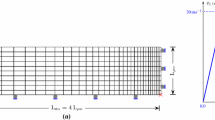Abstract
The new contribution of this study is to formulate two wellknown isotropic elastoplastic damage concepts for ductile materials in the framework of ‘geometrically exact’ finite multiplicative elastoplasticity. For the model originally proposed by Lemaitre the damage evolution follows from a dissipation potential and the hypothesis of general associativity. In contrast, the Gurson model takes into account the balance of mass separately to formulate damage evolution. In this contribution both formulations are based on logarithmic Hencky strains leading to a simple application of the so called ‘exponential map’ stress integrator which is the algorithmic counterpart of the multiplicative elastoplastic formulation adopted. Special emphasis is directed towards the numerical implementation of these models within the framework of finite element analysis of inelastic boundary value problems. To compare the results of numerical computations several standard examples within finite elastoplasticity are analysed with both damage models and the results are contrasted to the outcome of an analysis with the classical v. Mises model. thereby, the dramatic influence of damage on the behaviour within necking and localization computations is highlighted. The different behaviour of the two models considered within compression dominated problems is appreciated.
Similar content being viewed by others
References
Chaboche, J. L. 1981: Continous damage mechanics—a tool to describe phenomena before crack initiation. Nucl. Engr. Design 64: 233–247
Chaboche, J. L. 1988: Continuum damage mechanics: Part I—General concepts, Part II—Damage growth, crack initation and crack growth. J. Appl. Mech. 55: 59–72
Cuitiño, A.; Ortiz, M. 1992: A Material-independent method for extending stress update algorithms to finite plasticity with multiplicative kinematics. Engr. Comp. 9: 437–451
Dragon, A. 1985: Plasticity and ductile fracture damage: study of void growth in metals. Engr. Fract. Mech. 21: 875–885
Duszek, M. K.; Perzyna, P.; Stein, E. 1992: Adiabatic shear band localization in elastic-plastic damaged solids. Int. J. Plast. 8: 361–384
Eterovic, A. L.; Bathe, K. J. 1990: A hyperelastic-based large strain elasto-plastic constitutive formulation with combined isotropic-kinematic hardening using the logarithmic stress and strain measures. Int. J. Num. Meth. Engr. 30: 1099–1114
Gurson A. L. 1975: Plastic flow and fracture behaviour of ductile materials incorporating void nucleation, growth and interaction. Ph.D. Thesis, Division of Engineering, Brown University, Providence
Gurson, A. L. 1977: Continuum theory of ductile rupture by void nucleation and growth—yield criteria and flow rules for porous ductile Media. J. Engr. Mat. Techn. 99: 2–15
Kachanov, L. M. 1958: Time to the rupture process under creep conditions. Izv. Akad. Nauk SSR Otd. Tech. Nauk. 8: 26–31
Kachanov, L. M. 1986: Introduction to continuum damage mechanics. Martinus Nijhoff Publishers, Dordrecht
Krajcinovic, D. 1984: Continuum damage mechanics. Appl. Mech. Rev. 37: 397–402
Laborde, P.; Michrafy, A. 1991: On a general constitutive equations involving damage. Eur. J. Mech. A/Solids 10: 213–237
Lee, E. H. 1969: Elastic-plastic deformations at finite strains. J. Appl. Mech. ASME 36: 1–6
Lemaitre, J. 1984: How to use damage mechanics. Nucl. Engr. Design. 80: 233–245
Lemaitre, J. 1985: Coupled elasto-plasticity and damage constitutive equations. Comp. Meth. Appl. Mech. Engr. 51: 31–49
Lemaitre, J. 1985: A continuous damage mechanics model for ductile fracture. J. Engr. Mat. Techn. 107: 83–89
Lubliner, J. 1984: A maximum-dissipation principle in generalized plasticity. Acta Mech. 52: 225–237
Lubliner, J. 1986: Normality rules in large-deformation plasticity. Mech. Mat. 5: 29–34
Mazars, J. 1982: Mechanical damage and fracture of concrete structures. In: Advances in fracture research. Pergamon Press, Oxford
Miehe, C.; Stein, E. 1992: A canonical model of multiplicative elasto-plasticity. Formulation and aspects of the numerical implementation. Eur. J. Mech. A/Solids 11: 25–43
Miehe C. 1992: On the representation of Prandtl-Reuss-tensors within multiplicative elastoplasticity. Int. J. Plast. (in press)
Miehe C. 1992: Aspects of the formulation and numerical implementation of large strain isotropic elasticity. Accepted for publication in Int. J. Num. Meth. Engr.
Murakami, S. 1988: Mechanical modeling of material damage. J. Appl. Mech. 55: 280–286
Nagtegaal, J. C.; Parks, D. M.; Rice, J. R. 1974: On numerically accurate finite element solutions in the fully plastic range. Comp. Meth. Appl. Mech. Engr. 4: 153–177
Peric, D.; Owen, D. R. J.; Honnor, M. E. 1992: A Model for finite strain elasto-plasticity based on logarithmic strains: computational issues. Comp. Meth. Appl. Mech. Engr. 94: 35–61
Simo, J. C. 1988: A Framework for finite strain elastoplasticity based on the maximum plastic dissipation and the multiplicative decomposition: Part I and II. Comp. Meth. Appl. Mech. Engr. 66: 199–219; 68: 1–31
Simo, J. C. 1992: Algorithms for static and dynamic multiplicative plasticity that preserve the classical return mapping schemes of the infinitesimal theory. Comp. Meth. Appl. Mech. Engr. 99: 61–112
Simo, J. C.; Armero, F. 1992: Geometrically nonlinear enhanced strain mixed method and the method of incompatible Modes. Int. J. Num. Meth. Engr. 33: 1413–1449
Simo, J. C.; Miehe, C. 1992: Associated coupled thermoplasticity at finite strains: formulation, numerical analysis and implementation. Comp. Meth. Appl. Mech. Engr. 98: 41–104
Simo, J. C.; Taylor, R. L.; Pister, K. S. 1985: variational and projection methods for the volume constraint in finite deformation elasto-plasticity. Comp. Meth. Appl. Mech. Engr. 51: 177–208
Souza Neto E. A.; de Perić D.; Owen D. R. J. 1992: A computational model for ductile damage at finite strains. In: Proc. Conf. on Computational Plasticity; Barcelona 1992, 1425–1441
Steinmann P. 1992: Lokalisierungsprobleme in der Plasto-Mechanik Dissertation, Universität Karlsruhe (in German)
Tvergaard, V.; Needleman, A.; Lo, K. K. 1981: Flow localization in the plane strain tensile test. J. Mech. Phys. Solids 29: 115–142
Weber, G.; Anand, L. 1990: Finite deformation constitutive equations and a time integration procedure for isotropic, hyperelastic-viscoplastic solids. Comp. Meth. Appl. Mech. Engr. 79: 173–202
Author information
Authors and Affiliations
Additional information
Communicated by S. N. Atluri, 6 September 1993
Rights and permissions
About this article
Cite this article
Steinmann, P., Miehe, C. & Stein, E. Comparison of different finite deformation inelastic damage models within multiplicative elastoplasticity for ductile materials. Computational Mechanics 13, 458–474 (1994). https://doi.org/10.1007/BF00374241
Issue Date:
DOI: https://doi.org/10.1007/BF00374241




